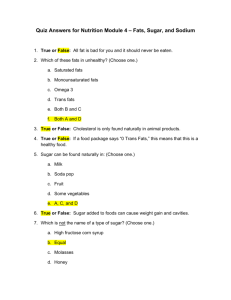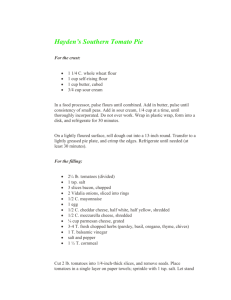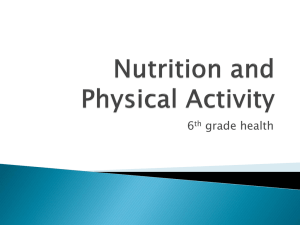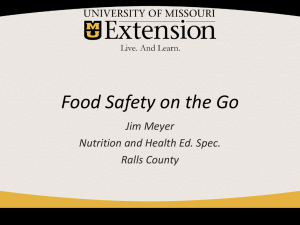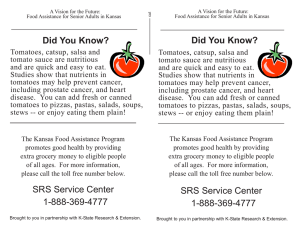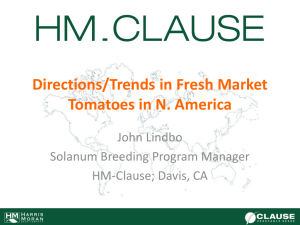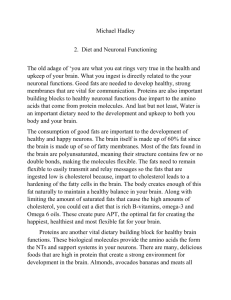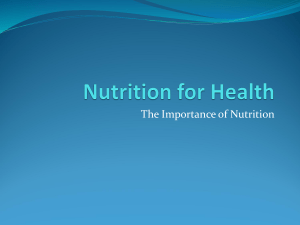Facts about Fats
advertisement
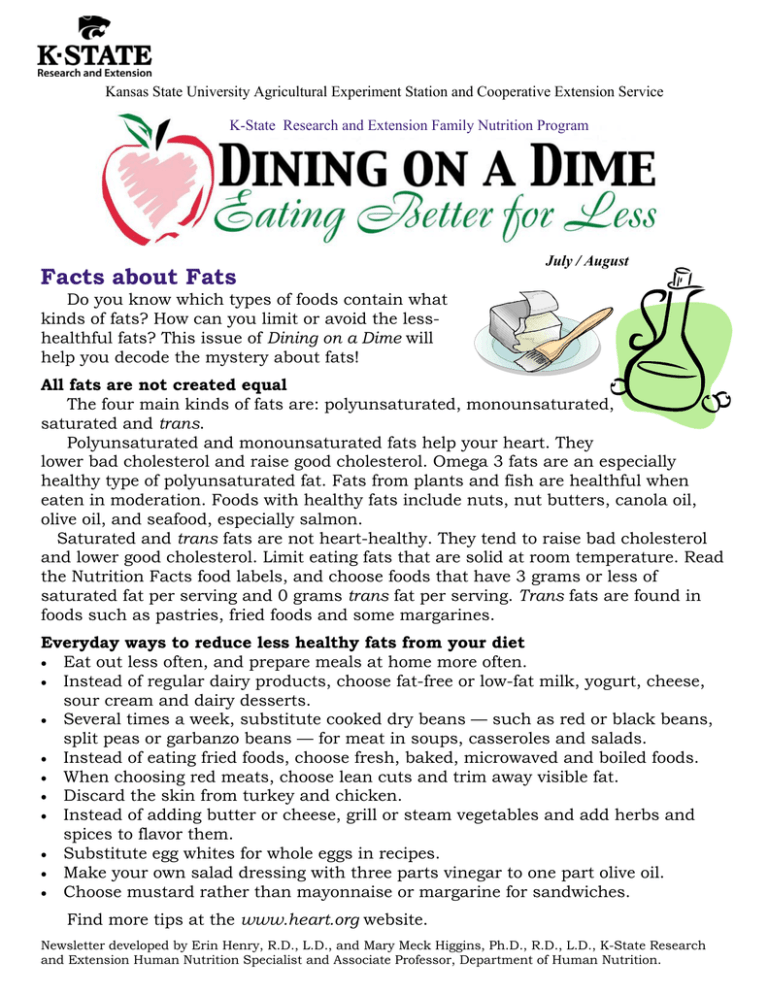
Kansas State University Agricultural Experiment Station and Cooperative Extension Service K-State Research and Extension Family Nutrition Program Facts about Fats July / August Do you know which types of foods contain what kinds of fats? How can you limit or avoid the lesshealthful fats? This issue of Dining on a Dime will help you decode the mystery about fats! All fats are not created equal The four main kinds of fats are: polyunsaturated, monounsaturated, saturated and trans. Polyunsaturated and monounsaturated fats help your heart. They lower bad cholesterol and raise good cholesterol. Omega 3 fats are an especially healthy type of polyunsaturated fat. Fats from plants and fish are healthful when eaten in moderation. Foods with healthy fats include nuts, nut butters, canola oil, olive oil, and seafood, especially salmon. Saturated and trans fats are not heart-healthy. They tend to raise bad cholesterol and lower good cholesterol. Limit eating fats that are solid at room temperature. Read the Nutrition Facts food labels, and choose foods that have 3 grams or less of saturated fat per serving and 0 grams trans fat per serving. Trans fats are found in foods such as pastries, fried foods and some margarines. Everyday ways to reduce less healthy fats from your diet Eat out less often, and prepare meals at home more often. Instead of regular dairy products, choose fat-free or low-fat milk, yogurt, cheese, sour cream and dairy desserts. Several times a week, substitute cooked dry beans — such as red or black beans, split peas or garbanzo beans — for meat in soups, casseroles and salads. Instead of eating fried foods, choose fresh, baked, microwaved and boiled foods. When choosing red meats, choose lean cuts and trim away visible fat. Discard the skin from turkey and chicken. Instead of adding butter or cheese, grill or steam vegetables and add herbs and spices to flavor them. Substitute egg whites for whole eggs in recipes. Make your own salad dressing with three parts vinegar to one part olive oil. Choose mustard rather than mayonnaise or margarine for sandwiches. Find more tips at the www.heart.org website. Newsletter developed by Erin Henry, R.D., L.D., and Mary Meck Higgins, Ph.D., R.D., L.D., K-State Research and Extension Human Nutrition Specialist and Associate Professor, Department of Human Nutrition. Page 2 Top Summer Food Safety Tips Food spoils faster in the summer. Why? Bacteria grow fastest in the heat and humidity. Also, more people cook outside at picnics, barbecues and on camping trips, where refrigeration and washing facilities can be hard to find. Fortunately, you can take steps to make sure your food is safe to eat, even during the summer heat. Plate it safe! Keep beverages in a separate cooler, since it will be opened more frequently. Pack perishable foods (such as luncheon meats, cooked meats and chicken, and potato or pasta salads) in an insulated cooler in sealed plastic bags under several inches of ice, ice packs or containers of frozen water. If packing raw meats, do not allow raw meat juices to touch ready-to-eat food. Do not partially cook food ahead of time: pack either raw or fully-cooked meat and poultry. Pack just the amount of perishable food that you can use. If a cold insulated cooler is not available, do not take perishable foods. Instead, pack foods such as hard cheeses, canned meats, chicken and tuna; nuts, peanut butter, dry cereals, bread, crackers, fruits and vegetables. Keep the cooler in the coolest part of the car. Place it in the shade or shelter it from the sun at the picnic site. Preserve the cold temperature of the cooler by replenishing the ice as needed. When planning a picnic, barbeque or camping trip, find out if there will be a source of safe drinking water. If not, take water for preparation and cleaning. Pack disposable washcloths and use them to clean your hands. Pack a food thermometer. Check meats with a food thermometer to be sure they reach an internal temperature of 145° F. for steaks and chops, 160° F. for ground meats, and 165° F. for poultry. Wash all plates, utensils and cutting boards that held raw meat or poultry with hot soapy water before using them again for cooked food. Perishable food that is not kept cold for more than 2 hours is not considered safe to eat. When summer heat gets above 90 degrees, foods left out of the cold cooler for more than 1 hour should be thrown away. Source (Accessed 6/19/13): Truncated from Handling Food Safely on the Road, USDA Food Safety & Inspection Service, www.fsis.usda.gov/wps/portal/fsis/topics/food-safety-education/get-answers/foodsafety-fact-sheets/safe-food-handling/handling-food-safely-on-the-road/ct_index#.UcHT0pzNm2M You may view previous newsletters at www.ksre.ksu.edu/HumanNutrition/p.aspx?tabid=184 This issue is an updated revision of the “Dining on a Dime July 2007” newsletter. Contents of this publication may be reproduced for educational purposes. All other rights reserved. In each case, credit Erin Henry and Mary Meck Higgins, “Dining on a Dime,” July 2013. Page 3 Top Tomatoes ‘Tis the season of tomatoes! Do you know the secrets for selecting, storing and serving the best of these tasty treats? Read on! Selection Often the best-tasting tomatoes are grown locally. Shop your local farmers market, if available. Look for tomatoes that are fragrant, heavy for their size, and give slightly to pressure. The skin should be smooth and free of blemishes. Examine the tomato’s color. Those that are the deepest in color are the ripest. Purchase tomatoes at various stages of ripeness, then use the ripest tomatoes first. Storage Tomatoes will ripen after being picked. Ripen them at room temperature with the stem end up. The “shoulders” of the stem end are the most tender part of the tomato and bruise easily. Sunlight is not necessary to ripen tomatoes. Placing them on a window sill is not recommended. They could become overheated, which prevents good color and flavor development, and increases the chance of decay. Since tomatoes will not continue to ripen at temperatures less than 55 degrees F., avoid refrigerating them until they are fully ripe. Fully ripe tomatoes may be stored in the refrigerator for two to three weeks. They will lose some color and flavor, but will still be good to eat. Serving If a recipe calls for peeled tomatoes, put them in boiling water for 30 seconds. Then immediately plunge them into cold water, drain, and make a slit in the blossom end to peel the skin back. Seed a tomato by cutting it in half crosswise, then removing seeds with the tip of a knife or spoon. Slice tomatoes from stem to blossom, lengthwise versus crosswise, to maintain maximum juice. Slice just before using to preserve juiciness, flavor and nutrients. Source (Accessed 6/19/13): Truncated from Selecting, Storing and Serving Ohio Tomatoes, Ohio State University Extension, www.ohioline.osu.edu/hyg-fact/5000/pdf/5532.pdf For more information about healthy eating, contact your local extension office. This material was funded by USDA’s Supplemental Nutrition Assistance Program. The Food Assistance Program can help people of all ages with low income buy nutritious foods for a better diet. To find out more, call 1-888-369-4777. Dining on a Dime’s Cooks’ Corner Cheese & Veggie Lasagna Casserole (Makes 2 servings) Ingredients 1 cup chopped broccoli, frozen or raw 1/4 cup uncooked macaroni 1/4 cup water 1/2 cup shredded part-skim mozzarella cheese, divided 1/4 cup nonfat cottage cheese 1 tablespoon grated Parmesan cheese 1/2 cup spaghetti sauce Cooperative Extension Service 1/2 cup diced tomato, fresh or canned K-State Research and Extension Directions 1. In a bowl, combine broccoli, macaroni, water, 1/4 cup mozzarella cheese, and all of the other two cheeses. 2. Spray a 1-quart baking dish with non-stick cooking spray. Add broccoli mixture. Top with spaghetti sauce. 3. Cover baking dish. Bake at 350° F. for 40 minutes. 4. Sprinkle the casserole with tomato and 1/4 cup mozzarella cheese. Bake uncovered 5 minutes. 5. Remove from oven. Wait 5 minutes before serving. 6. Cover and K-State, County Extension Councils, refrigerate leftovers within 2 hours. Nutrition Facts per Extension Districts, and the U.S. 1/2 recipe, about 1 1/2 cups: 220 calories, 7g fat, 3.5g saturated fat, 0g trans fat, 24g carbohydrates, 16g protein, 20mg cholesterol, 650mg sodium and 3g dietary fiber. Daily Values: 20% vitamin A, 45% vitamin C, 30% calcium, 8% iron. Department of Agriculture cooperating. K-State is an equal opportunity provider and employer.
